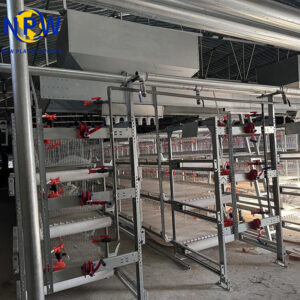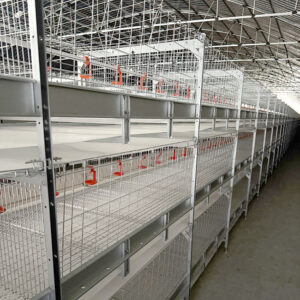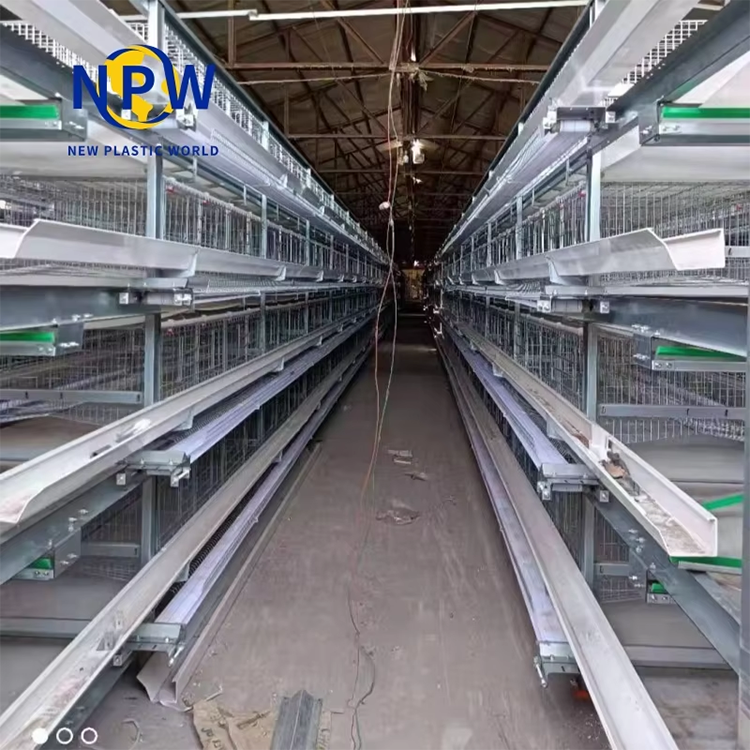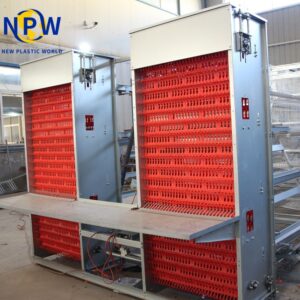Choosing the right type of chicken cage is a cornerstone of successful poultry farming. Whether you’re raising chickens for eggs, meat, or nurturing delicate baby chicks, selecting the appropriate cage system directly impacts productivity, animal health, and operational efficiency. In this article, we’ll delve into the three primary types of chicken cages—layer cages, broiler cages, and brooder cages—detailing their key features, advantages, ideal applications, and practical considerations to help you make informed decisions for your farm.
1. Layer Chicken Cages (For Egg-Laying Hens)
Tailored specifically for egg-laying hens, these cages are engineered to create an optimal environment that boosts egg production while streamlining daily operations. Their design revolves around maximizing the efficiency of egg collection and maintaining hen health.
Key Features:
- Multi-tier configuration:Utilizes vertical space effectively, enabling a higher number of hens to be housed in a given area compared to traditional floor systems. This is particularly valuable for farms with limited land resources.
- Gradually sloped floors:The gentle incline (typically 5–8 degrees) ensures that eggs roll smoothly into a designated collection trough, minimizing manual handling during collection.
- Integrated feeding and drinking systems:Positioned at optimal heights to allow easy access for hens, these systems reduce feed waste and ensure a constant supply of clean water, which is crucial for consistent egg production.
- Efficient manure removal mechanisms:These can range from manual scrapers in smaller setups to automated belt systems in large-scale operations, keeping the cage environment clean and lowering the risk of bacterial or parasitic infections.
Benefits:
- Significantly increases the number of eggs produced per square meter of space, directly enhancing farm profitability.
- Reduces egg breakage (a common issue in floor-rearing systems) and contamination from dirt, feces, or pests, resulting in a higher proportion of marketable eggs.
- Simplifies daily management tasks such as monitoring hen health, adjusting feed rations, and collecting eggs, which saves time and labor costs.
Ideal For: Commercial egg farms of all sizes that prioritize high productivity and seek to implement varying levels of automation. Smaller farms can opt for semi-automated versions, while large-scale operations may benefit from fully automated systems with computerized monitoring.
2. Broiler Chicken Cages (For Meat Chickens)

Designed with the unique needs of broiler chickens in mind, these cages focus on creating an environment that promotes rapid, uniform weight gain while minimizing stress and disease risks. Broilers have different requirements than layers, as their growth 周期 is shorter (typically 6–8 weeks) and their bodies are heavier, requiring sturdier housing.
Key Features:
- Durable wire mesh flooring:The mesh is designed to support the increasing weight of broilers as they grow, with gaps sized to allow feces to fall through, keeping the birds clean and reducing contact with waste.
- Adequate compartment space:Each broiler needs enough room to move, stand, and lie down comfortably. Overcrowding can lead to stunted growth, pecking behavior, and increased mortality, so cage dimensions are calculated based on the expected final weight of the birds.
- Enhanced ventilation design:Proper airflow is essential for regulating temperature (broilers are sensitive to heat stress) and removing moisture, ammonia, and other harmful gases. This is achieved through strategic placement of vents, fans, or natural ventilation systems depending on the climate.
- Automated feeding and watering setups:These systems deliver precise amounts of feed and water at regular intervals, ensuring that all broilers have equal access, which promotes uniform growth and reduces competition among birds.
Benefits:
- Facilitates faster and more consistent weight gain in a hygienic setting, as broilers are less exposed to pathogens present in floor litter.
- Results in lower mortality rates compared to traditional floor-rearing, where birds are more prone to diseases like coccidiosis or respiratory infections from contaminated litter.
- Makes it easier to monitor individual bird growth, adjust feeding schedules based on growth rates, and coordinate the harvesting process, which is crucial for meeting market deadlines.
Ideal For: Poultry farms that specialize in raising meat chickens, whether they are small-scale operations supplying local markets or large commercial facilities producing for national or international meat suppliers. They are particularly beneficial in regions where land is expensive or where biosecurity concerns are high, as cage systems offer better control over the birds’ environment.
3. Brooder Chicken Cages (For Chicks)

The early weeks of a chick’s life are critical for its long-term health and development. Brooder cages provide a nurturing environment that protects vulnerable chicks (from 0 to 6 weeks old) from temperature fluctuations, predators, and diseases, setting the foundation for healthy growth.
Key Features:
- Fine mesh size:The small gaps in the mesh prevent young chicks from escaping or getting their legs trapped, which could cause injuries or deformities.
- Temperature control elements:Heating lamps, heating pads, or built-in heating systems maintain the optimal temperature for chicks, which starts at around 32–35°C in the first week and is gradually reduced by 2–3°C each week until they are acclimated to room temperature.
- Multi-layer structure with dividers:Allows for easy separation of chicks by age, size, or breed, preventing bullying and ensuring that weaker chicks get adequate access to food and warmth.
- Easy-to-clean materials:Cages are often made of galvanized steel or plastic components that can be quickly washed and disinfected, which is essential for preventing the spread of diseases like Marek’s disease or infectious bronchitis.
Benefits:
- Provides a stable, controlled environment that supports proper growth and development, including the development of a strong immune system.
- Reduces stress in chicks, which can have long-term negative effects on growth rates (in broilers) or egg production (in layers). This leads to higher survival rates, often exceeding 95% in well-managed brooder systems.
- Prevents overcrowding, which can cause uneven growth and increase the risk of cross-contamination between birds.
Ideal For: Hatcheries, small-scale poultry farms that raise their own chicks, and large commercial operations that start with day-old chicks. They are also valuable for farms that specialize in rare or heritage breeds, where the survival of each chick is particularly important.
Conclusion
Selecting the right chicken cage system—whether for layers, broilers, or chicks—is a decision that should be based on your farm’s specific goals, scale, and resources. Layer cages optimize egg production and collection, broiler cages focus on efficient weight gain, and brooder cages lay the groundwork for healthy chick development. By investing in the appropriate cage system, you can enhance productivity, reduce operational costs, and ensure the well-being of your flock.
If you’re planning to start a new poultry farming venture or upgrade your existing setup, it’s advisable to work with a reputable poultry equipment supplier who can assess your needs and recommend the best cage design, taking into account factors such as automation level, climate conditions, and future expansion plans. With the right equipment in place, you’ll be well-positioned to achieve success in the competitive poultry industry.


